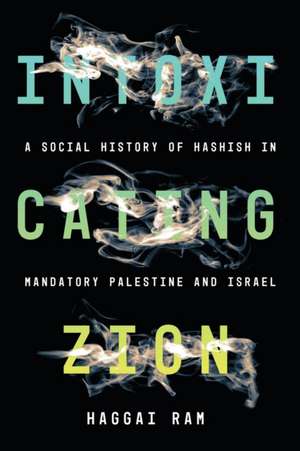Intoxicating Zion – A Social History of Hashish in Mandatory Palestine and Israel
Autor Haggai Ramen Limba Engleză Paperback – 26 oct 2020
Intoxicating Zion is the first book to tell the story of hashish in Palestine/Israel. Trafficking, use, and regulation; race, gender, and class; colonialism and nation-building all weave together in Haggai Ram's social history of the drug from the 1920s to the aftermath of the 1967 War. The hashish trade encompassed smugglers, international gangs, residents, law enforcers, and political actors, and Ram traces these flows through the interconnected realms of cross-border politics, economics, and culture. Hashish use was and is a marker of belonging and difference, and its history offers readers a unique glimpse into how the modern Middle East was made.
| Toate formatele și edițiile | Preț | Express |
|---|---|---|
| Paperback (1) | 191.39 lei 3-5 săpt. | |
| MK – Stanford University Press – 26 oct 2020 | 191.39 lei 3-5 săpt. | |
| Hardback (1) | 690.92 lei 6-8 săpt. | |
| MK – Stanford University Press – 26 oct 2020 | 690.92 lei 6-8 săpt. |
Preț: 191.39 lei
Nou
36.63€ • 38.16$ • 30.45£
Carte disponibilă
Livrare economică 18 ianuarie-01 februarie 25
Specificații
ISBN-10: 1503613917
Pagini: 272
Dimensiuni: 151 x 226 x 19 mm
Greutate: 0.36 kg
Editura: MK – Stanford University Press
Cuprins
This chapter explores the evolution of the Levant hashish trade between Lebanon in the north and Egypt in the south. This trade was a classic case of unintended consequences. It was brought about by local and international drug regulatory regimes in the late nineteenth and early twentieth centuries, culminating in the 1925 League of Nations Opium Convention, which extended global controls over cannabis products. These controls denied Egypt access to its main hashish supply source in the Greek archipelago. As supplies from Greece declined, Egyptians turned to Lebanese-grown cannabis to compensate for the loss of Greek supply. This shift in supply source inevitably led to a shift in supply routes to Egypt, which from this point on had to pass through Palestine, whether by land, sea, or air.
This chapter examines Mandatory Palestine's enmeshment in the Levant hashish trade. It reconstructs the "biographies" or "life histories" of the henceforth illicit commodities crossing the Levant through the Lebanon-Palestine-Egypt axis, demonstrating that political boundaries were of no concern for smugglers and traffickers. At the same time, it focuses on the subterfuges and ruses employed by hashish traffickers trespassing in Palestine to get their contraband across Egypt's borders, and on the failure of the Palestine Police Force to deal with these circumstances effectively. Combined, these perspectives underscore the perforated nature of the borders between the Mandate states, which eroded the legitimacy of the colonial state.
Contrary to nineteenth- and twentieth-century Orientalist representations, hashish consumption in late-Ottoman Palestine was negligible. This state of affairs changed dramatically in the course of the mandatory period due to the territory's emergence as a critical link in the Levant hashish trade between Lebanon in the north and Egypt in the south. With some of the Egypt-bound supply left behind for the local market, the availability of hashish caused a significant rise in consumption, mainly by the country's urban working-class Arab population. By the 1930s, hashish smoking had spread throughout Palestine's towns and cities. Venues for consumption¿makeshift hashish dens, coffeehouses, brothels¿proliferated in these towns, and many a person could be seen wandering the streets intoxicated. The Palestine Police Force was unequipped to deal with this circumstance effectively.
Mandatory Palestine's Jews tended to steer well clear of hashish. By exploring the public discourse of Palestine's burgeoning Jewish community and drawing on interwar colonial knowledge produced by the League of Nations, I demonstrate that the underlying reason for this abstention was fear of accommodating an "alien" Oriental artifact. Not unlike sodomy and homosexuality in pre-1948 Zionist discourse, hashish came to symbolize for Jews a stereotypical marker of Oriental barbarism. Jews considered hashish taking a form of "backwardness" linked to the realities of living among Arabs in the Middle East. It appeared to expose Jewish bodies to the dangerous temptations of an alien space, culminating in Jewish overassimilation into the Levantine environment.
This chapter follows the changing patterns of hashish smuggling and antihashish enforcement in the transition to the State of Israel up to 1967. The enduring Egyptian demand for hashish and the Lebanese capacity to satisfy it ensured the survival of the Levant hashish trade after 1948. With Israel's new borders superimposed on existing smuggling routes, and with the Israel Police suffering from several constraints, the trade was not radically disrupted, hashish traffickers (Jews and Arabs alike) coming up with new deceptions to get their contraband safely to Egypt. Also discussed is the alleged intensive involvement of the Israeli military in hashish trafficking operations from Lebanon to Egypt, from the late 1950s to as recently as the mid-1980s. The attributed objective of this long-standing and highly confidential enterprise was to immerse and immobilize the Egyptian population, and specifically the Egyptian military, with hashish.
The conclusion ties together the various perspectives discussed in the book: the movement of hashish supplies across and beyond Palestine-Israel, the culture of hashish use by Jews and Arabs, drug-control efforts, and the discourses in which they were all embedded. It argues that, despite evolving circumstances and changing regulatory regimes, the hashish trade continued unabated, new outlets emerging continuously as the number of hashish users also continued to rise. At the same time, the conclusion explains why the 1967 Arab-Israeli War should be considered a watershed in the history of hashish in the region, and it offers a brief, albeit first-of-its-kind-review of hashish use in Israel from 1967 to the present, tracing the slow process of cannabis's normalization in Jewish Israeli society.
